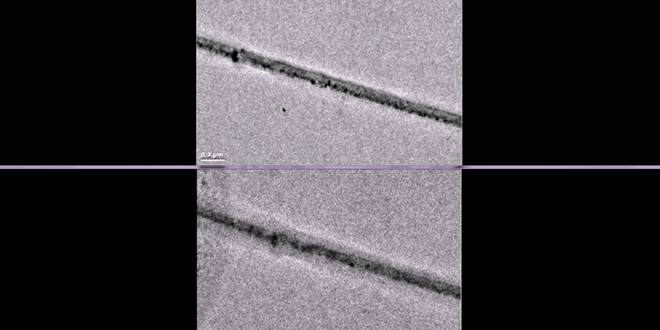Electricity may seem invisible, but storing it in batteries has some very physical effects. As a battery is charged and discharged, electrons and ions rush around from place to place, sometimes causing electrodes to change their shapes over time. As researchers experiment with improved electrode materials, it’s critical to get a microscopic view of what those peripatetic particles are up to, and see how physical changes may be degrading battery function.
Now a group of researchers at the DOE’s Pacific Northwest National Laboratory has developed a way to study battery electrodes while they are bathed in wet electrolytes, mimicking realistic conditions inside actual batteries. The team’s work, reported in the latest issue of Nano Letters, showed that many aspects of battery behavior can be effectively studied under dry conditions. However, wet conditions are needed to get a more accurate picture, and especially to study an elusive phenomenon called the solid electrolyte interphase layer, a coating that accumulates on an electrode’s surface.
“The liquid cell gave us global information about how the electrodes behave in a battery environment,” said materials scientist Chongmin Wang. “And it will help us find the solid electrolyte layer. It has been hard to directly visualize in sufficient detail.”
Wang and colleagues have used high-powered microscopes to watch how the ebbing and flowing of positively charged ions deform electrodes. Until now, the transmission electron microscopes have only been able to accommodate dry (or open) battery cells. In a real battery however, electrodes are bathed in liquid electrolytes that provide an environment ions can easily move through.

Wang’s team built a battery with one silicon electrode and one lithium metal electrode, both contained in a bath of electrolyte. When the team charged the battery, they saw the silicon electrode swell, as expected. However, under dry conditions, the electrode is attached at one end to the lithium source, and swelling starts at just one end. In this study’s liquid cell, lithium could enter the silicon anywhere along the electrode’s length. The team watched as the electrode swelled all along its length at the same time.
“The electrode got fatter and fatter uniformly. This is how it would happen inside a battery,” said Wang. “We have been studying battery materials with the dry, open cell for the last five years. We are glad to discover that the open cell provides accurate information with respect to how electrodes behave chemically. It is much easier to do, so we will continue to use them.”
Wang still hasn’t observed the elusive solid electrolyte interphase layer, but hopes to be able to increase the resolution enough to get a glimpse of it in a future experiment.
“The layer is perceived to have peculiar properties and to influence the charging and discharging performance of the battery,” said Wang. “However, researchers don’t have a concise understanding or knowledge of how it forms, its structure, or its chemistry. Also, how it changes with repeated charging and discharging remains unclear. It’s very mysterious stuff. We expect the liquid cell will help us to uncover this mystery layer.”
Images courtesy of Gu et al, Nano Letters 2013
Source: Pacific Northwest National Laboratory



















































